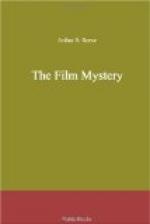“Do you—do you know who it is?” he demanded.
“Not yet,” Kennedy replied. “First I must marshal all my evidence.”
“Who—who do you want present in the projection room?”
“Mr. Phelps, Mr. Millard, and—yourself, Mr. Manton. Miss Loring and Miss Faye. Mr. Gordon. Anyone else who wishes, if there is room.”
“Phelps, Millard, Gordon, and the two girls are inside already.”
“Good! We will start at once.”
Manton turned, to lead the way in. At that moment there was a call from the yard. We stopped, looking up. It was Shirley.
“Wait just a minute,” he cried. He was so weak that the two extra men who were helping him virtually supported his weight. On his face was a look of desperate determination. “I—I must see this too!” he gasped.
XXXII
CAMERA EVIDENCE
Coming in from the bright light of open day, the projection room seemed a gloomy, forbidding place, certainly well calculated to break down the reserve of perhaps the cleverest criminal ever pitting his skill against the science of Craig Kennedy.
It was a small room, long and not so wide, with a comparatively low ceiling. In order to obviate eye strain the walls were painted somberly and there were no light colors in evidence except for a nearly square patch of white at the farther end, the screen upon which the pictures were projected. The illumination was very dim. This was so that there would be no great contrast between the light reflected from the images cast upon the screen during pictures and the illumination in the room itself between reels; again designed to prevent strain upon the eyes of the employees whose work was the constant examination of film in various stages of its assembly.
The chairs were fastened to the floor, arranged in tiny crescents and placed so as not to interfere with the throw of the pictures from behind. The projection machines themselves, two in number in order to provide continuous projection by alternating the reels and so threading one machine while running the other, were in a fireproof booth or separate room, connected with the tiny auditorium only by slits in the wall and a sort of porthole through which the operator could talk or take his instructions.
Directly beneath the openings to the booth were a table equipped with a shaded lamp, a stand for manuscripts, and a signal button. Here the film cutters and editors sat, watching the subject upon which they worked and making notes for changes, for bits of superfluous action to be cut out, or for titles or spoken inserts to be moved. At a signal the operator could be instructed to stop at any point, or to start, or to wind back and run some given piece over again. The lights in the room were controlled from within the booth and also by a switch just at the side of the door. A telephone on the table offered a connection with any part of the studio or with the city exchanges, so that an official of the company could be reached while viewing a picture.




